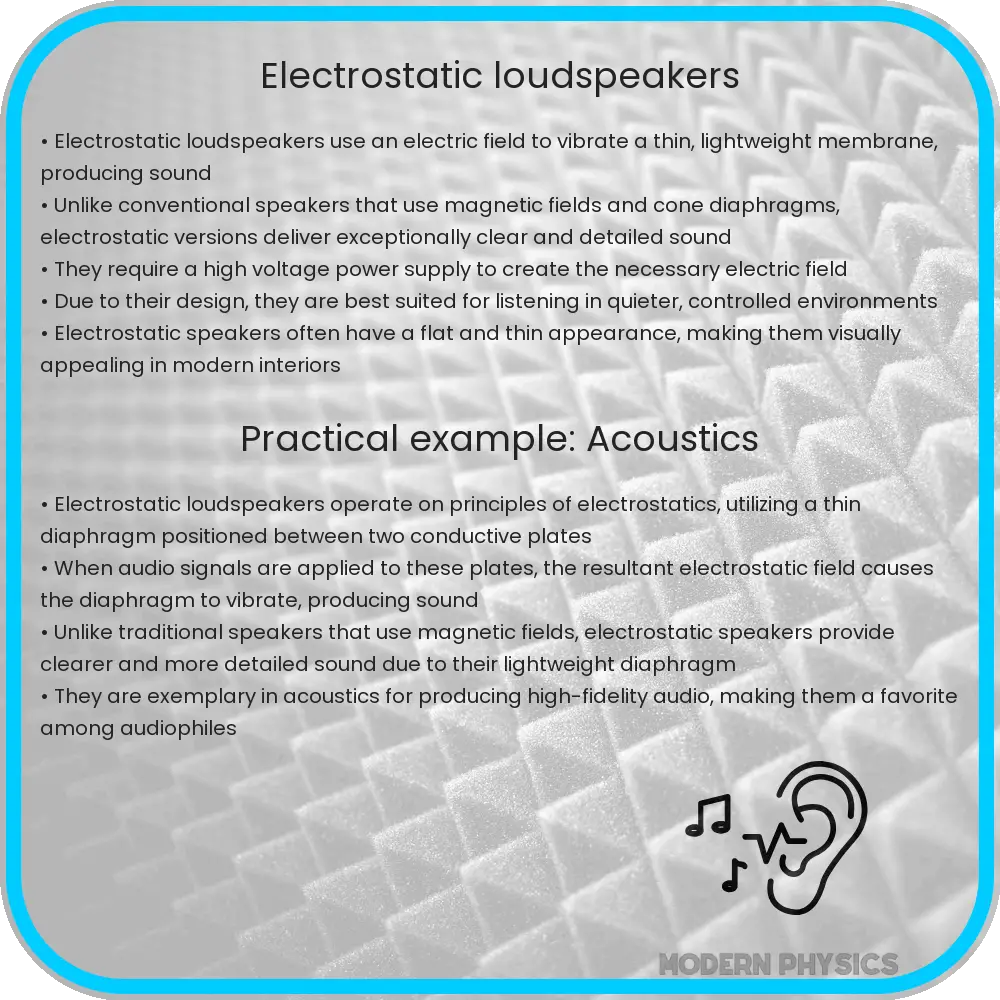Learn how electrostatic loudspeakers deliver superior sound quality through their unique design and electrostatic force-based audio production.

Understanding Electrostatic Loudspeakers: Clarity, Precision & Depth in Acoustics
Electrostatic loudspeakers, often hailed for their superb sound quality, operate on principles distinct from those of conventional dynamic loudspeakers. These devices leverage electrostatic forces to produce sound with remarkable precision and depth, offering an unparalleled listening experience. This article explores how electrostatic loudspeakers work and why they are so valued by audiophiles.
Principles of Electrostatic Loudspeakers
The foundation of an electrostatic loudspeaker lies in its unique design, which uses an electric field to vibrate a thin membrane situated between two conductive panels. This configuration is starkly different from traditional speakers, which typically employ a magnetic field to move a cone or dome.
- Basic Construction: An electrostatic speaker consists of three primary components:
- A thin, electrically conductive diaphragm, usually made from a lightweight material like Mylar.
- Two electrically conductive stationary plates (stators), placed on either side of the diaphragm.
- An insulating frame to keep the components in place and prevent electrical discharges.
- Generating Sound: The process begins when an audio signal is applied to the stators. This creates a fluctuating electric field. The diaphragm, having a fixed positive charge, is alternately attracted to one or the other charged stator depending on the signal’s polarity at any given moment. This rapid movement of the diaphragm pushes and pulls the adjacent air molecules, creating sound waves.
Electrostatic vs. Dynamic Speakers
While both types of speakers have their own advantages, electrostatic speakers are particularly known for their ability to reproduce audio with exceptional clarity and detail. Here’s a brief comparison:
| Feature | Electrostatic Speaker | Dynamic Speaker |
|---|---|---|
| Sound Quality | Produces very accurate and detailed sound with almost no distortion. | Generally good, but can be susceptible to distortion at higher volumes. |
| Frequency Response | Extremely flat and wide, leading to very natural sound reproduction. | Varies, but often less even than electrostatic speakers, leading to potential coloration of sound. |
| Directionality | Highly directional, which can create a ‘sweet spot’ for listeners positioned directly in front of the speaker. | Less directional, providing a more consistent sound quality across different listening positions. |
Electrostatic speakers’ ability to handle complex audio signals with minimal interference and distortion is due to their inherent design, which eliminates many of the mechanical constraints found in dynamic speakers. This principal advantage is the key to their exceptional fidelity and sharpness in sound reproduction.
Challenges and Considerations in Electrostatic Speaker Design
Despite their superior sound quality, electrostatic loudspeakers come with their own set of challenges that need careful consideration:
- Power Requirements: Electrostatic speakers require a high voltage power supply for operation, making them more demanding in terms of energy consumption compared to conventional dynamic speakers.
- Sensitivity to Humidity: Humidity can affect the performance of the diaphragm. In high humidity environments, these speakers might suffer from a reduction in sound precision and possible damage to the components.
- Physical Size: Generally, electrostatic speakers are larger and more cumbersome than traditional speakers. This can make installation and room placement a challenge.
- Price: Due to the complex manufacturing process and the high-quality materials required, electrostatic speakers tend to be more expensive.
These factors make electrostatic speakers less versatile and accessible for the average consumer, but their unparalleled audio quality keeps them in high demand among audiophiles and professionals in the music industry.
Conclusion
Electrostatic loudspeakers, with their intricate construction and operational principles, stand out as a premier choice for those seeking the utmost in sound clarity and detail. While they face certain practical challenges such as size, sensitivity to environmental factors, and cost, their ability to deliver pristine and accurate audio makes them a favorite in high-fidelity setups.
The distinctive mechanism of using an electrostatic field to vibrate a thin diaphragm gives these speakers an edge in reducing audio distortion, a common issue in conventional dynamic speakers. Despite the sweet spot in terms of listener position and their substantial power requirements, the crispness and lifelike quality of the sound produced can transform any listening experience into something truly spectacular.
For those passionate about sound quality and who are willing to invest in premium audio equipment, electrostatic loudspeakers offer a listening experience that is hard to surpass. With ongoing advancements in technology and design, the future might hold more innovative solutions to make these high-end devices more accessible to a broader audience.
